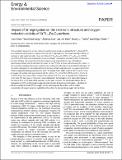Impact of Sr segregation on the electronic structure and oxygen reduction activity of SrTi[subscript 1−x]Fe[subscript x]O[subscript 3] surfaces
Author(s)
Chen, Yan; Cai, Zhuhua; Kim, Jae Jin; Tuller, Harry L.; Yildiz, Bilge; Jung, Woo Chul; ... Show more Show less
DownloadSTF Manuscript revised final 03262012 yildz.pdf (610.7Kb)
OPEN_ACCESS_POLICY
Open Access Policy
Creative Commons Attribution-Noncommercial-Share Alike
Terms of use
Metadata
Show full item recordAbstract
The correlation between the surface chemistry and electronic structure is studied for SrTi[subscript 1−x]Fe[subscript x]O[subscript 3] (STF), as a model perovskite system, to explain the impact of Sr segregation on the oxygen reduction activity of cathodes in solid oxide fuel cells. Dense thin films of SrTi[subscript 0.95]Fe[subscript 0.05]O[subscript 3] (STF5), SrTi[subscript 0.65]Fe[subscript 0.35]O[subscript 3] (STF35) and SrFeO[subscript 3] (STF100) were investigated using a coordinated combination of surface probes. Composition, chemical binding, and valence band structure analysis using angle-resolved X-ray photoelectron spectroscopy showed that Sr enrichment increases on the STF film surfaces with increasing Fe content. In situ scanning tunnelling microscopy/spectroscopy results proved the important and detrimental impact of this cation segregation on the surface electronic structure at high temperature and in an oxygen environment. While no apparent band gap was found on the STF5 surface due to defect states at 345 °C and 10[superscript −3] mbar of oxygen, the surface band gap increased with Fe content, 2.5 ± 0.5 eV for STF35 and 3.6 ± 0.6 eV for STF100, driven by a down-shift in energy of the valence band. This trend is opposite to the dependence of the bulk STF band gap on the Fe fraction, and is attributed to the formation of a Sr-rich surface phase in the form of SrO[subscript x] on the basis of the measured surface band structure. The results demonstrate that Sr segregation on STF can deteriorate oxygen reduction kinetics through two mechanisms – inhibition of electron transfer from bulk STF to oxygen species adsorbing onto the surface and the smaller concentration of oxygen vacancies available on the surface for incorporating oxygen into the lattice.
Date issued
2012-04Department
Massachusetts Institute of Technology. Department of Materials Science and Engineering; Massachusetts Institute of Technology. Department of Nuclear Science and Engineering; Massachusetts Institute of Technology. Laboratory for Electrochemical InterfacesJournal
Energy & Environmental Science
Publisher
Royal Society of Chemistry
Citation
Chen, Yan, WooChul Jung, Zhuhua Cai, Jae Jin Kim, Harry L. Tuller, and Bilge Yildiz. “Impact of Sr Segregation on the Electronic Structure and Oxygen Reduction Activity of SrTi1−xFexO3 Surfaces.” Energy & Environmental Science 5, no. 7 (2012): 7979.
Version: Author's final manuscript
ISSN
1754-5692
1754-5706